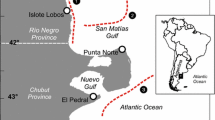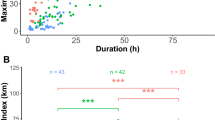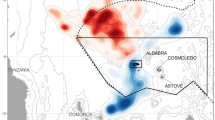Abstract
Dietary segregation of sympatric seabirds in the Southern Ocean is partly linked to differences in their foraging techniques. We have investigated the activity of giant petrels (Macronectes spp.) in a king penguin (Aptenodytes patagonicus) colony day and night during the austral winter of 2001 on the Crozet Islands. Using an automatic identification system and an infrared video camera, we followed 15 petrels tagged with micro transponders. Our data show that giant petrels predate king penguin chicks during the night. The activity of giant petrels is even slightly higher during nighttime than during the day. In addition, our data show a higher nocturnal activity by northern giant petrels (M. halli) than by southern giant petrels (M. giganteus). These unexpected results raise questions concerning visual adaptations to nocturnal foraging in giant petrels and their potential impact on the sleep, vigilance and crèching behavior of penguin chicks.
Similar content being viewed by others
Avoid common mistakes on your manuscript.
Introduction
The differential exploitation of food resources by seabirds is linked to their foraging techniques which depend on behavioral and physiological adaptations such as visual (Martin and Prince 2001), olfactory (Nevitt 1999; Bonadonna et al. 2001) or diving capacities (Costa 1991). Data on the foraging behavior of seabirds during the night remain scarce. Previous studies have been essentially limited to albatrosses at sea (e.g. Weimerskirch et al. 1993; Croxall and Prince 1994; Fernandez and Anderson 2000). This paucity of data for night feeding is largely due to the technological difficulties associated with observations at night. The diet, feeding ecology at sea and the foraging activity of giant petrels (Macronectes spp.) have been investigated during daytime (Hunter and Brooke 1992; Warham 1996; Gonzalez-Solis et al. 2001). Giant petrels feed both by direct predation and by scavenging carrion (Hunter and Brooke 1992). Southern (M. giganteus) and northern (M. halli) giant petrels are considered the main king penguin (Aptenodytes patagonicus) predators, in particular for the chicks during the winter (Hunter and Brooke 1992). It has been assumed that giant petrels do not feed nocturnally in penguin colonies (Hunter 1991). However, to our knowledge, the nocturnal activity of giant petrels has only been addressed in a single study which dealt with how they behave at sea during the breeding season.
The aim of this study was to determine the activity of giant petrels over the 24-h cycle in a king penguin colony during the austral winter on the Crozet Islands, and to compare the activities of both species of giant petrels using an automatic identification system associated with an infrared video camera.
Materials and methods
The study was carried out in a colony of 25,000 pairs of king penguins at Possession Island (46°25′S, 51°45′E) in the Crozet Archipelago, between May and August 2001. A breeding area with about 10,000 pairs (about 0.8 ha) is connected to the sea by three pathways which giant petrels use to walk into or leave the penguin colony.
Between March and July 2001, seven southern giant petrels and eight northern giant petrels were randomly caught in the penguin colony. The visual feature which can be used to confidently distinguish the species is the color of the end plates of the bill, greenish in southern giant petrels and reddish in northern giant petrels (Voisin 1968; Conroy et al. 1975). A miniature transponder tag weighing 0.8 g (TIRIS) was implanted under the bird's skin between the leg and tail.
Antennas for bird identification are installed permanently on the three pathways (Fig. 1; see also Descamps et al. 2002 for a complete description). The system consists of two buried antennas 3 m apart on each pathway. Each antenna is 3–5 m wide, supplying energy to the passive transponders, which are activated electromagnetically at a distance of about 70 cm and receive in response the identification code of an individual upon each passage. The antennas are connected to a computer which collects the data on the number of daily passages of each bird. The sequence of signals from the two antennas on each pathway reveals if a bird is entering or leaving the breeding site (data collected for the incomplete month of the transponder implantation are excluded from the analysis). In this study, we took into account all daily crossings of each bird occurring during these 4 months.
A remote-controlled infrared video camera working 5 times slower than real time was put on the pathway where the majority of the passages occurred. We directed it so as to cover one-third of the studied area. During the month of May, the video tapes were studied at the times the transponded giant petrels passed between the antennas. We defined night passages as those between sunset and sunrise. A tear-off calendar specifically adapted to the Crozet Islands was used to determine when sunset and sunrise occurred for each month.
The effect of species and month on the percentage of nocturnal passages was analyzed with two-way ANOVAs with unequal sample size (Snedecor and Cochran 1980). Arcsine transformations (Sokal and Rohlf 1981) were performed on the percentage of nocturnal passages in order to obtain normal distributions. All tests were two-tailed. Results are considered to be significant at the 5% level. Values reported are means ± SE.
Results
The movements of the 15 giant petrels in the penguin colony were greater at night (ANOVA: F 1,14=12, P<0.01) since, for the 4 months, an average of 71% of the passages occurred at night. Over the 24-h cycle, giant petrels showed a peak of activity around sunrise (between 0600 and 0900 hours; Fig. 2). From then on, the movements of the birds progressively decreased until sunset. A strong reduction of activity occurred in the daylight hours, chiefly from 1300 to 1700 hours. In addition, both species of giant petrels were active day and night, but M. halli were significantly more active than M. giganteus over the 24-h cycle (ANOVA: F 1,14=12.24, P<0.05) independent of the month during which the data were collected (ANOVA: F 1,14=0.41, P=0.75). Comparison of nocturnal versus diurnal activity of each species is shown in Fig. 3.
Number of daily crossings of giant petrels [7 southern (M. giganteus) and 8 northern (M. halli) giant petrels] in the penguin colony over the 24-h cycle (time = UTC+5). a May 2001; b June 2001; c July 2001; d August 2001. For each column, the data is the median number of crossings of all identified birds ± SE
Nocturnal predation on king penguin chicks by giant petrels occurred every night as shown by the video recordings. Most often, the predator ran at one or a group of chicks in order to isolate one individual and bring it down by biting it around the head and neck. Once the chick weakened, the attacker bit the anal area.
Discussion
In the present study, the activity of both species of giant petrels has been investigated day and night in a king penguin colony during the austral winter. Contrary to what has been assumed, giant petrels remained active during the night to predate king penguin chicks. This is therefore the first study to provide data on nocturnal predation by giant petrels.
Indeed, both giant petrels can be characterized as opportunistic predator-scavengers, but had been assumed to be diurnal. Hunter (1991) reported that giant petrels did not hunt nocturnally in penguin colonies while stipulating that any kills may have been missed in his direct observations. Using activity recorders on giant petrels, with the sensors indicating when the birds were at sea or on land, Gonzalez-Solis et al. (2001) documented their activity patterns during the incubation period. This indicated that giant petrels usually travel at sea during daylight and are less active at night, which implies that the birds spend much of the night on land. This therefore accords with our observation in the present study that giant petrels engaged in nocturnal predation during all 4 months of the study, suggesting that their presence on land at night not only is not unusual, but may be an integral part of their foraging strategy. Accordingly, the quantification of time-activity budgets of giant petrels would benefit from a more detailed description of night activities.
The higher activity of giant petrels at night may be due to a larger vulnerability of penguin chicks in darkness. Giant petrels would consequently have a higher capture success at night. During the winter, king penguin chicks congregate in flocks of several dozens to several thousands of individuals, the so-called crèches. Crèching behavior offers adaptive benefits as protection from predators (Munro and Bédard 1977; Seddon and Van Heezik 1993). In particular, animals in groups benefit from an increased probability of detecting a predator (Dimond and Lazarus 1974; Elgar 1989). The nocturnal predation by giant petrels probably has evolutionary consequences on the sleep, vigilance and crèching behavior of penguin chicks.
These results also raise questions concerning the visual adaptations to nocturnal foraging in giant petrels and king penguins. Penguins and albatrosses show amphibious optical design (Martin 1998) and the king penguin eye's optical design facilitates vision at low light levels (Martin 1999). These adaptations have been suggested as offering a facility for underwater foraging. In king penguins, this could reduce predation risk during the night. The visual capacity of giant petrels at low light levels seems not, however, to have been investigated. Good nocturnal vision would offer them help in moving and catching penguin chicks at night.
References
Bonadonna F, Spaggiari J, Weimerskirch H (2001) Could osmotaxis explain blue petrels ability in returning to their burrows at night? J Exp Biol 204:1485–1489
Conroy JW, Bruce G, Furse JR (1975) A guide to the plumages and iris colours of the giant petrels. Ardea 63:87–92
Costa DP (1991) Reproductive and foraging energetics of high latitude penguins, albatrosses and pinnipeds: implications for life history patterns. Am Zool 31:111–130
Croxall JP, Prince PA (1994) Dead or alive, night or day: how do albatrosses catch squid? Antarct Sci 6:155–162
Descamps S, Gauthier-Clerc M, Gendner JP, Le Maho Y (2002) The annual breeding cycle of unbanded king penguins Aptenodytes patagonicus on Possession Island (Crozet). Avian Sci 2:87–98
Dimond S, Lazarus J (1974) The problem of vigilance in animal life. Brain Behav Evol 9:60–79
Elgar MA (1989) Predator vigilance and group size in mammals and birds: a critical review of the empirical evidence. Biol Rev 64:13–33
Fernandez P, Anderson DJ (2000) Nocturnal and diurnal foraging activity of Hawaiian albatrosses detected with a new immersion monitor. Condor 102:577–584
Gonzalez-Solis J, Croxall JP, Briggs RD (2001) Activity patterns of giant petrels, Macronectes spp., using different foraging strategies. Mar Biol 140:197–204
Hunter S (1991) The impact of avian predator-scavengers on King penguins Aptenodytes patagonicus chicks at Marion Island. Ibis 133:343–350
Hunter S, Brooke MDL (1992) The diet of giant petrels Macronectes spp. at Marion island, Southern Indian Ocean. Colon Waterbirds 15:56–65
Martin GR (1998) Eye structure and amphibious foraging in albatrosses. Proc R Soc Lond B 265:665–671
Martin GR (1999) Eye structure and foraging in King Penguins Aptenodytes patagonicus. Ibis 141:444–450
Martin GR, Prince PA (2001) Visual fields and foraging in Procellariiform seabirds: sensory aspects of dietary segregation. Brain Behav Evol 57:33–38
Munro J, Bédard J (1977) Gull predation and crèching behaviour in the common eider. J Anim Ecol 46:799–810
Nevitt G (1999) Foraging by seabirds on an olfactory landscape. Am Sci 87:46–53
Seddon PJ, Van Heezik Y (1993) Chick crèching and intraspecific aggression in the jackass penguin. J Field Ornithol 64:90–95
Snedecor GW, Cochran WG (1980) Statistical methods, 7th edn. Iowa State College Press, Ames, Iowa
Sokal RR, Rohlf FJ (1981) Biometry, 2nd edn. Freeman, New York
Voisin J-F (1968) Les pétrels géants (Macronectes halli et Macronectes giganteus) de l'île de la Possession (Archipel Crozet). Oiseau Rev Fr Ornithol [special] 38:95–122
Warham J (1996) The behaviour, population biology and physiology of the petrels. Academic Press, San Diego
Weimerskirch H, Salamolard M, Sarrazin F, Jouventin P. (1993) Foraging strategy of wandering albatrosses through the breeding season: a study using satellite telemetry. Auk 110:325–342
Acknowledgements
This study was supported by the Institut Polaire Français—Paul-Emile Victor (Programme 137) and by the project Zones Ateliers of the Programme Environnement Vie et Société of the CNRS. The program received the agreement of the ethical committee of the French Polar Institute. We thank C. Salmon for his help in preparing software for the data set analysis.
Author information
Authors and Affiliations
Corresponding author
Rights and permissions
About this article
Cite this article
Le Bohec, C., Gauthier-Clerc, M., Gendner, JP. et al. Nocturnal predation of king penguins by giant petrels on the Crozet Islands. Polar Biol 26, 587–590 (2003). https://doi.org/10.1007/s00300-003-0523-y
Received:
Accepted:
Published:
Issue Date:
DOI: https://doi.org/10.1007/s00300-003-0523-y







